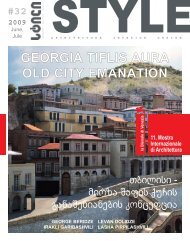Tbilisis haiat parki Hyatt Park Tbilisi siyvarulidan ... - Style Magazine
Tbilisis haiat parki Hyatt Park Tbilisi siyvarulidan ... - Style Magazine
Tbilisis haiat parki Hyatt Park Tbilisi siyvarulidan ... - Style Magazine
You also want an ePaper? Increase the reach of your titles
YUMPU automatically turns print PDFs into web optimized ePapers that Google loves.
American Roadside Architecture<br />
The United States Embassy in <strong>Tbilisi</strong>, Georgian Union of Architects and ARCI Gallery<br />
host the American Roadside Architecture Exhibition. The exhibition was dedicated to celebrating<br />
150 years of American Institute of Architects – AIA.<br />
On May 15, the United States Embassy<br />
in <strong>Tbilisi</strong> and the Georgian Union of Architects<br />
opened the photographic exhibition “American<br />
Roadside Architecture” at ARCI Gallery. The exhibition,<br />
created by architectural historian John<br />
Margolies, comprised 56 photos and four text<br />
panels that depicted the early architecture of<br />
gas stations, roadside lodging, restaurants and<br />
eateries.<br />
American roadside architecture is drawn from<br />
Mr. Margolies’s extensive series of books on<br />
the subject of popular American architecture.<br />
For more than 25 years, John Margolies crisscrossed<br />
the United States, camera in hand, to<br />
capture and preserve images of a vanishing tradition<br />
in American commerce. The photos displayed<br />
at ARCI Gallery document a unique and<br />
fast disappearing American architecture designed<br />
to appeal primarily to motoring tourists, one that<br />
relied heavily on local culture and sensibilities.<br />
They are the artifacts of a creative, whimsical<br />
and very inviting moment in American business<br />
and tourism.<br />
The exhibit has been shown in Kiev,<br />
Yekaterinburg, Perm, Vladivostok, Athens,<br />
Chisinau, Prague, Ankara Paris, Zagreb, Tallinn<br />
and most recently at UNESCO headquarters<br />
in Paris.<br />
John Margolies’s more than 30-year career<br />
in architecture has included video and photo<br />
documentations, as well as many books and<br />
publications on architectural history. His annual<br />
lectures series at the Architectural League<br />
of New York and the Royal Society of Architects<br />
in London regularly draw large audiences.<br />
American Roadside Architecture at ARCI<br />
Gallery will be open in <strong>Tbilisi</strong> May 15-May 22<br />
at 21 T. Abuladze Street, <strong>Tbilisi</strong>. The exhibit<br />
will also tour the following cities: Telavi (May<br />
24-May 29), Kutaisi (May 31-June 6), Batumi<br />
(June 8-June 17), Poti (June 19-June 24) and<br />
Zugdidi (June 26-June 29). As part of the exhibit,<br />
Fulbright Professor from the Yale School of<br />
Architecture, Dr. Lena Kiladze, will give a lecture<br />
on the architectural design in each city.<br />
The invention and mass production of the<br />
automobile transformed the livers of Americans<br />
and the landscape of the United States in the<br />
20th century. During the 19th century, travel was<br />
cumbersome and expensive. Existing roads were<br />
mostly rough dirt paths and difficult to navigate.<br />
The predetermined routes and schedules of railroads<br />
or the slow pace of travel by horse and<br />
carriage placed limitations on people anxious<br />
to explore the wonders of the country.<br />
But all this began to change as cars<br />
became affordable for millions of people, and<br />
good roads were built to accommodate the steadily<br />
increasing numbers of motorists now set free<br />
to discover the country on their own schedules<br />
and routes. The American free enterprise system<br />
responded, creating new types of businesses<br />
geared specifically to the needs of these “automobilists”.<br />
“Moms and Pops” across the U.S.<br />
built facilities beside the highways to provide<br />
the necessities: gas, food and lodging. Distinctive<br />
and individualistic roadside buildings, often with<br />
huge signs proclaiming their presence, screamed<br />
for attention to attract those customers passing<br />
by at higher speeds. Their designs were a<br />
kind of visual shorthand, intended to attract attention<br />
and to get customers to STOP.<br />
stili #23. 2007<br />
137





